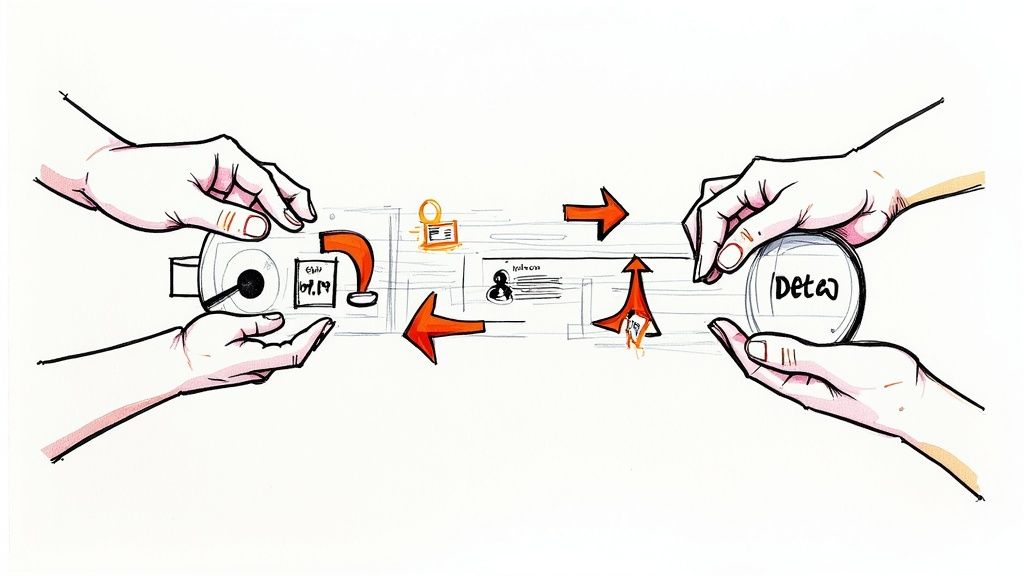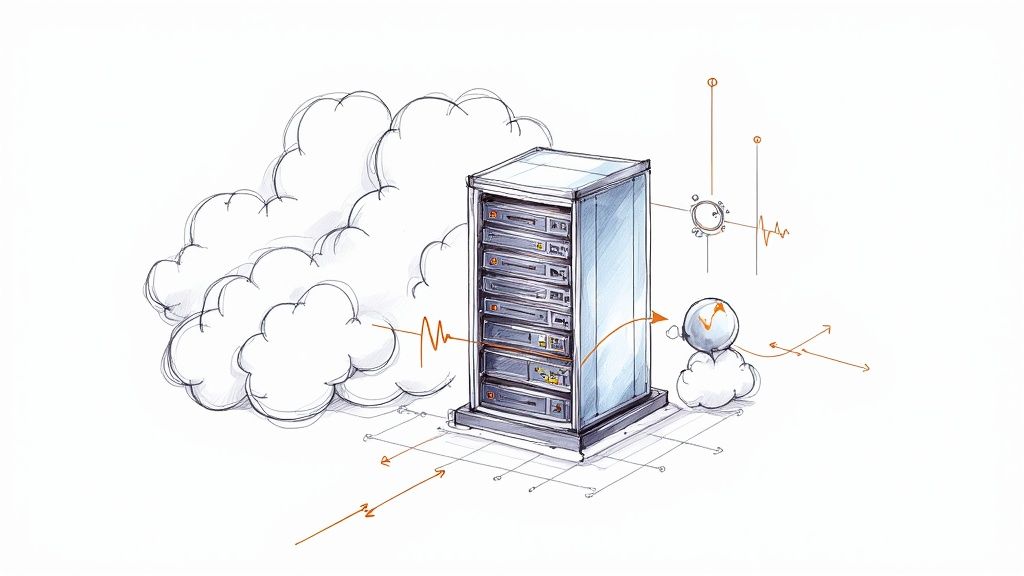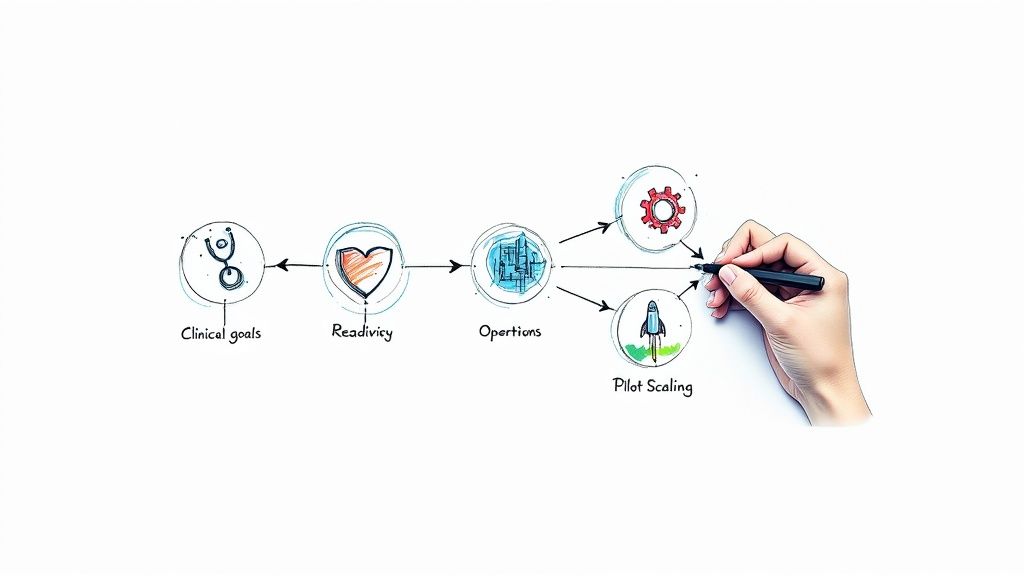Your AI Implementation Roadmap for Business Growth
Build a winning AI implementation roadmap with this expert guide. Learn to align AI with business goals, select high-impact projects, and scale your success.

An AI implementation roadmap is, quite simply, a strategic plan. It lays out the exact steps your organization will take to weave artificial intelligence into its operations to hit specific business goals. Think of it as a living, breathing guide that connects tech projects to real-world, measurable outcomes. This kind of planning prevents those costly missteps and turns AI from a buzzword into a true engine for growth.
Why Your Business Needs an AI Implementation Roadmap
Jumping into AI without a clear plan is like setting sail without a map. You know you want to get to the "business growth" island, but the waters are full of potential hazards. An AI implementation roadmap gives you that essential direction, making sure your investments in new tech and talented people actually lead to meaningful results instead of just draining your budget. It’s what helps you move from scattered, one-off experiments to a coordinated, powerful strategy.
The pressure to get on board with AI is real and growing. The global AI market is on a trajectory to explode from $391 billion in 2025 to nearly $1.81 trillion by 2030. It's no surprise that 83% of companies now see AI as a top business priority. The question has shifted from if you should adopt AI to how you're going to do it. You can dig deeper into these AI market trends to see just how competitive things are getting. This explosive growth just hammers home the need for a solid plan that balances big ambitions with down-to-earth execution, a topic we touched on in our AI adoption guide.

The Core Purpose of a Strategic Roadmap
A well-crafted roadmap does more than just list tasks on a timeline; it's a complete blueprint that ties every single action back to your main objectives. This kind of strategic alignment is the bedrock of effective AI co creation, a process where technology and business goals grow together, hand-in-hand.
Here’s what a solid roadmap really helps you nail down:
- Aligns Stakeholders: It gets everyone on the same page. From the boardroom to the IT department, a shared vision ensures people understand the goals and how their work contributes.
- Manages Resources: The plan is your guide for allocating budget, tech, and people where they'll make the biggest impact first. No more guessing games.
- Mitigates Risks: You can spot potential roadblocks—like messy data, skill gaps, or tricky integration issues—long before they become full-blown crises. This lets you build solutions ahead of time.
- Measures Success: It sets up clear metrics and KPIs from the start. This allows you to track progress, prove the ROI of your AI projects, and make a strong case for continued investment.
To give you a clearer picture, here's a breakdown of what every solid roadmap should include.
Core Components of a Successful AI Roadmap
| Component | Objective | Key Action |
|---|---|---|
| Business Goals | To connect every AI initiative to a specific, measurable business outcome. | Identify top-priority business challenges or opportunities that AI can address. |
| Use Case Prioritization | To focus resources on the projects with the highest potential impact and feasibility. | Score potential AI projects based on value, effort, and risk. |
| Data Strategy | To ensure the availability, quality, and governance of data needed for AI models. | Conduct a data audit and create a plan for data collection, storage, and access. |
| Technology & Infrastructure | To select the right tools and build a scalable foundation for AI. | Evaluate current systems and decide whether to build, buy, or partner for AI tech. |
| Talent & Skills | To address skill gaps and build a team capable of executing the roadmap. | Assess internal capabilities and plan for training, hiring, or outsourcing. |
| Execution Plan | To outline a realistic timeline with clear milestones, owners, and dependencies. | Break down projects into phases (e.g., pilot, scale, optimize) and assign responsibilities. |
| Governance & Ethics | To establish clear guidelines for the responsible and ethical use of AI. | Develop policies for data privacy, model transparency, and fairness. |
| Metrics & ROI | To define how success will be measured and tracked over time. | Set specific KPIs for each project and establish a system for ongoing monitoring. |
This table serves as a quick checklist to ensure your planning is comprehensive. Each piece is crucial for building a plan that's not just visionary but also practical.
Ultimately, the aim is to create a plan that pushes the boundaries while staying grounded in what’s actually achievable. A great way to get started is by using a proven AI strategy framework to give your thinking some structure and make sure no critical pieces are missed. In the next few sections, we’ll show you exactly how our expert team walks through this process.
Laying Your Strategic Foundation
So, you're ready to build an AI roadmap. Where do you start? It's tempting to jump straight into the exciting tech—the algorithms, the data, the platforms. But that’s a classic mistake. The most successful AI initiatives don’t begin with technology; they begin with a solid, well-thought-out strategy.
This initial phase is all about discovery and getting your house in order. It's about making sure every step you take later is deliberate and directly contributes to a real business outcome.
Think about it this way: diving into AI without this foundational work is like building a house on sand. You might get a few projects off the ground, but they'll likely be disconnected and won't deliver the value you're hoping for. The numbers back this up. While only 35% of companies have a formal AI strategy, a whopping 78% of those that do are already seeing a return on their investment. That's a powerful argument for starting with strategy first.
Define Your Business Objectives
Before anything else, you have to answer one simple question: "Why?" What business problem are you actually trying to solve? Vague goals like "we need to do AI" are a fast track to wasted time and money. Your objectives need to be crystal clear, measurable, and tied directly to what matters most to your business.
Most strong AI objectives fall into one of three buckets:
- Growing Revenue: This could look like using AI to create hyper-personalized marketing campaigns that actually convert, refining your lead scoring so sales chases the right prospects, or even creating brand new AI-powered products.
- Cutting Costs: Think about automating those mind-numbing back-office tasks that drain your team's time. Or maybe it's about optimizing your supply chain with predictive logistics or using AI to forecast equipment failures before they happen.
- Improving the Customer Experience: This is a big one. You could deploy smart chatbots that provide instant, 24/7 support, personalize every user's journey on your website, or analyze customer feedback at scale to pinpoint exactly what needs fixing.
Figuring this out isn't a job for one person in a dark room. The best way to set these goals is through a collaborative AI co creation process. Get leaders from every department in a room—sales, marketing, operations, finance—to make sure the goals reflect the needs of the entire organization, not just a single team's pet project.
Conduct a Thorough Readiness Assessment
Once you know what you want to accomplish, you need an honest look at where you're starting from. A readiness assessment is essentially a reality check on your organization's current capabilities. It’s the step that stops you from creating a roadmap based on wishful thinking.
I've seen this happen time and again: companies think they have a ton of data, but when we dig in, it's a mess—siloed in different systems, unstructured, or just plain poor quality. Tackling this data problem early is absolutely essential.
Your assessment should be a deep dive into a few key areas:
- Data and Infrastructure: Is your data clean, accessible, and high-quality? What are your rules around data governance and privacy?
- Tech Stack: What systems are you running on now? Can your current architecture even handle AI workloads, or are major upgrades needed?
- People and Skills: Does your team have the chops for data science, machine learning, and AI ethics? Pinpointing skill gaps now lets you plan for training or strategic hiring down the road.
- Company Culture: Is your organization open to making decisions based on data and comfortable with a bit of experimentation? AI adoption is as much about change management as it is about technology.
This audit gives you a clear-eyed view of the road ahead. To keep it organized, using a proven AI strategy framework can be incredibly helpful, guiding you methodically through each of these critical areas.
Secure Stakeholder Alignment
An AI roadmap without widespread support is dead on arrival. Getting stakeholder alignment means ensuring everyone—from the C-suite down to the folks on the front lines—is on board with the vision. This isn't just about a single kickoff meeting; it's about fostering an ongoing conversation.
Start by mapping out your key stakeholders in every relevant department: IT, finance, operations, marketing, you name it. Then, communicate the "why" in a way that resonates with each of them. Show them what's in it for them.
For instance, that new AI-powered inventory system won't just cut costs (which gets the CFO excited), it will also mean fewer stockouts and less manual data entry for the operations team. When people see how it makes their lives better, they become champions for the project.
This process of building consensus is a core part of effective AI strategy consulting. It turns a simple document into a shared mission, creating the collaborative spirit you'll need to navigate the inevitable bumps in the road. Without it, you're just asking for resistance and budget battles when you can least afford them.
Identifying and Prioritizing AI Use Cases
Alright, you've got your strategic goals lined up. Now comes the exciting part: moving from the big-picture 'why' to the practical 'what'. This is where we start figuring out exactly where AI can make a real difference in your day-to-day business. The aim here is to get past the buzzwords and pinpoint high-value projects that actually fit how your company works.
This whole process kicks off with conversations, not code. You absolutely have to get people from different departments in a room (or on a call) to brainstorm. Talk to sales, marketing, operations, customer service—everyone. Ask them: What are the biggest headaches in your workflow? Where are you losing hours to repetitive, mind-numbing tasks? What are the customer complaints you hear over and over that current tools just can't solve?
You’ll probably end up with a massive, sprawling list of potential real-world use cases. That’s a great sign. It means your team is engaged and thinking creatively. But let's be honest, not all ideas are winners. A common mistake I see is companies chasing a shiny, new AI trend that ultimately has very little impact. That’s a surefire way to kill your momentum before you even get started.
Creating a Scoring Framework for Prioritization
To sidestep that trap, you need a smart way to sift through the noise. A simple scoring framework is your best friend here. It brings a dose of objectivity to the table and helps you focus on projects that strike the right balance between big wins and what's actually possible. This kind of methodical evaluation is a core part of our AI strategy consulting because it turns a wish list into a concrete plan.
The idea is to judge every potential project against the same set of criteria. Here’s a model you can steal and adapt:
- Business Value (1-5): How much will this move the needle on key metrics like revenue, cost savings, or customer happiness? A project that automates 20 hours of manual data entry a week is clearly more valuable than one saving 20 minutes.
- Feasibility (1-5): Can we actually pull this off? Be realistic about your data quality, the technical complexity, and the skills you have on your team right now.
- Strategic Alignment (1-5): How well does this idea support the main business goals we just defined? If a project directly helps you achieve a core objective, it gets a higher score.
Once you score each idea, you'll have a prioritized list. The projects with the highest scores are your top contenders for pilot programs. Think of these as your "quick wins"—the projects most likely to succeed and show everyone else in the company what AI can do. This builds the buy-in you'll need for bigger investments down the road.
The most successful AI roadmaps don't start with the most complex projects. They start with highly visible, high-impact projects that solve a real, recognized business pain. Proving value early on is the key to getting long-term buy-in.
From Brainstorming to Actionable Insights
Let’s walk through a quick example. Imagine a retail company is weighing two AI projects: a predictive system for inventory management versus an AI chatbot for their website.
- Inventory System: This scores high on Business Value (fewer stockouts means more sales and lower carrying costs) but gets a low score on Feasibility because it needs data from a mess of old, clunky systems.
- Chatbot: This scores a bit lower on Business Value (it improves customer response time, which is good but not game-changing) but gets a perfect score on Feasibility. It can be built with an off-the-shelf tool and fed with clean data from the existing FAQ page.
In this scenario, the chatbot is probably the smarter first move. It's a quick win that delivers immediate, visible value. It also lets the team cut their teeth on an AI project before they try to tackle the much more complicated inventory system.
For a more structured way to get this done, using an AI requirements analysis tool can seriously speed up the discovery and evaluation process. The graphic below shows how you can start thinking about building the team you need for these kinds of projects.

Ultimately, you’re not just ending this phase with a list of ideas. You’re walking away with a ranked backlog of pilot projects that will become the beating heart of your entire AI implementation roadmap.
Building Your Technical and Data Infrastructure
You’ve pinpointed the high-impact use cases. Now it's time to build the engine that will actually power them. Any AI implementation roadmap is only as solid as the technical and data foundation it’s built on. This next step is all about making the tough infrastructure decisions that will support not just your first few projects, but your AI ambitions for years to come.
Think of it this way: your data is the fuel, and your technology stack is the engine. It doesn't matter how sleek the car is; if you put bad fuel in a weak engine, you're not going anywhere. The same is true for AI. Poor data or a rickety infrastructure will cause your initiatives to sputter out before they even get a chance to get going.
The New Economics of AI Infrastructure
The good news? Building this engine has never been more within reach. The cost of getting started with AI has dropped dramatically in recent years, opening the doors for businesses of all sizes to get in the game. It’s a complete economic shift that allows for more ambitious projects without the massive capital investment that was required just a few years ago.
The numbers really tell the story. Between 2022 and 2024, the inference cost for a model performing at the level of GPT-3.5 plummeted an incredible 280-fold. At the same time, AI hardware costs have been dropping by about 30% annually, and energy efficiency has improved by around 40% each year. This combination seriously lowers the total cost of ownership, making AI a truly viable option for a much wider range of companies. You can dig deeper into this evolving cost landscape in the 2025 AI Index Report.

Key Infrastructure Decisions
Working through your infrastructure options means taking a hard look at your current capabilities, your budget, and where you want to be in the long run. Here are the core decisions you'll need to sort out.
- Build vs. Buy vs. Partner: Do you have the in-house talent to build custom AI solutions from the ground up? Or does an off-the-shelf platform make more sense right now? There’s also a third path: partnering with a specialist firm, which often gives you the best of both worlds—a tailored solution without the long-term overhead. If you're weighing these options, exploring our https://www.ekipa.ai/implementation-support can bring a lot of clarity.
- Cloud vs. On-Premise: Cloud platforms like AWS, Google Cloud, and Azure offer amazing scalability and a whole suite of pre-built AI services, which is why they're so popular. On the other hand, on-premise solutions give you total control over your data, but they require a significant upfront investment and a team to maintain them.
- Data Architecture and Governance: How are you going to collect, store, clean, and secure your data? This isn't just a technical question; it's a strategic one. Setting up a solid data governance framework is non-negotiable. It’s what ensures your data quality is high, protects customer privacy, and keeps you compliant with regulations like GDPR.
A classic mistake I see all the time is underestimating the data prep work. Teams get excited and budget 80% of their time for building the model and only 20% for the data. In the real world, you should flip those numbers. Clean, well-structured data is everything in AI.
Designing a Scalable Data Architecture
Sure, your first project might only need a small, focused dataset. But you have to design your data architecture with the future in mind. A scalable architecture means that as your AI initiatives get bigger and more complex, your systems can handle the load without needing a complete, and costly, overhaul.
This means thinking ahead about data pipelines, storage solutions, and how people will access the data they need. Modern approaches like data lakes and data mesh architectures are built for this kind of flexibility, letting different teams tap into data securely and efficiently without stepping on each other's toes.
For deploying AI models in a way that’s both scalable and efficient, it's worth looking into container orchestration platforms. This technical guide to Kubernetes consulting services offers some great insights into what an expert partnership can do for managing that kind of infrastructure. By making smart, forward-thinking choices now, you build a technical environment where innovation can actually happen, ensuring your AI roadmap has the horsepower it needs to deliver real business value.
Assembling Your Team and Managing Change
You can have the best technology in the world, but it’s the people who make or break a project. Once you've mapped out the technical side of your AI plan, it's time to focus on the human element. This is where you assemble a skilled team and, just as importantly, guide your organization through the inevitable shifts that AI brings.
Let's be clear: success comes down to having the right people in the right seats. You have a few options here. You can look for external specialists, train your existing employees, or bring in outside experts who already have the experience you need. As you make these foundational decisions, the process of hiring top AI engineers becomes absolutely central to your success.
Building Your Core AI Team
A strong AI team is more than just a group of coders; it's a mix of technical gurus and sharp business minds. You need people who can see a project through from a great idea to a fully launched product.
Some of the key players you'll need on your bench are:
- AI Strategist/Product Manager: This is the person who keeps the AI work tied directly to business goals. They ensure every project actually delivers real, measurable value.
- Data Scientist/ML Engineer: These are your technical builders. They're the ones who create, train, and fine-tune the AI models.
- Data Engineer: Think of them as the architects of your data infrastructure. They make sure clean, high-quality data is always flowing where it needs to go.
- AI Project Manager: This role is essential for keeping everything moving. They manage timelines, wrangle resources, and bridge the communication gap between the tech team and other departments.
You don't have to fill all these roles on day one. A lot of companies get started by working with our expert team to steer their first few projects. This gives you immediate access to top-tier expertise while you take a more deliberate approach to building your own in-house talent.
Proactively Managing Organizational Change
AI can feel disruptive. If you don't manage the human side of this transition, you’re going to hit resistance that can stop even the best-laid plans in their tracks. Building an AI-ready culture doesn't happen by accident—it’s something you have to cultivate with clear communication and a genuine effort to empower your people.
The numbers tell a compelling story. Projections show that by 2025, around 97 million people globally will be working in AI-related jobs. This isn't just about new roles popping up; it's about existing ones changing. With 83% of companies making AI a priority, the race for talent is on, making it crucial that your roadmap has a solid human capital strategy. You can find more on the AI workforce transformation at Superhuman.com.
Fostering an AI-ready culture is less about the technology and more about psychology. It’s about replacing fear of the unknown with curiosity and excitement for new possibilities.
To get ahead of the curve, here’s where to focus:
- Be Radically Transparent: Talk openly about why you're bringing in AI and what it means for everyone—not just the company’s bottom line, but for individual employees. Frame it as a tool that will enhance their abilities, not replace them.
- Invest in Your People: Figure out what new skills your team needs to work with AI and set up training programs to get them there. It shows you're committed to their growth.
- Find Your AI Champions: In every department, there are people who are excited about new technology. Identify them, empower them, and let them become advocates who can help their colleagues adapt.
- Start Small, Win Big: As we explored in our AI adoption guide, kicking off with smaller pilot projects is a great way to show the benefits of AI without taking on too much risk. Early wins create momentum and get people on board naturally.
By treating team-building and change management as core parts of your AI roadmap, you're not just preparing your people for the future—you're making them active participants in creating it. For hands-on help navigating this journey, our AI strategy consulting is here to guide you.
Putting the Plan in Motion: Governance and Scaling
This is where the rubber meets the road. You’ve done the hard work of creating a thoughtful AI roadmap, and now it’s time to bring that strategy to life. Execution isn't about one big, dramatic launch; it’s a living process of building, measuring, and learning, all wrapped in a strong governance framework.
The smartest way forward is to be agile. Forget the high-risk, "big bang" approach. Instead, focus on the prioritized pilot projects you've already identified. Think of these as controlled experiments. Their job is to test your assumptions, give you real-world data, and score some quick wins to build momentum and excitement. Every pilot is a chance to learn, refining not just the AI solution itself, but your entire roadmap for what comes next.

Laying Down the Rules with Strong AI Governance
As soon as you start building, governance has to be top of mind. This isn't just corporate red tape; it's the essential rulebook that ensures your AI is used responsibly, safely, and in a way that reflects your company's values and the law. Get this wrong, and you're looking at potential reputational disasters, regulatory penalties, and a complete erosion of customer trust.
A solid governance framework needs to cover a few key bases:
- Ethical Guardrails: What does your organization stand for when it comes to fairness, accountability, and transparency in AI? You need clear processes for auditing models for bias and making sure their decisions can be explained.
- Data Privacy and Security: Lock down your protocols. How is data collected, stored, and used to train models? This has to be ironclad and compliant with regulations like GDPR.
- Keeping Up with the Law: AI legislation is changing fast. Someone on your team needs to own the task of monitoring these changes and making sure your policies adapt.
- Proactive Risk Management: What could go wrong? For every AI use case, you should identify potential risks—from a model giving bad outputs to malicious misuse—and have a plan to deal with them.
This can't be a document that gathers dust on a server. Governance has to be an active, breathing part of the entire AI lifecycle.
Measuring What Matters and Proving ROI
To keep the investment flowing and figure out what to scale, you have to be relentless about measuring the impact of your AI projects. This means circling right back to the business goals you set at the very beginning and tracking the key performance indicators (KPIs) that actually mean something to the business.
Don’t get stuck on technical vanity metrics like model accuracy. The KPIs that truly matter are the ones that measure business impact: lower costs, more revenue, and happier customers.
Let's say you roll out an AI chatbot for customer service. The number of chats it handles is interesting, but it's not the real story. You should be tracking:
- Operational Wins: A measurable drop in the average handle time for your human agents.
- Customer Impact: A clear improvement in customer satisfaction (CSAT) scores.
- The Bottom Line: A real decrease in your contact center's operational costs.
It’s absolutely critical to get a baseline before you launch. That's the only way you can definitively prove the value your AI solution delivered and build an undeniable case for scaling it up.
From Pilot Success to Scalable Powerhouse
The end game here isn't just to launch a couple of cool projects. The real goal is to build a sustainable, scalable AI capability that becomes part of your organization's DNA. When a pilot project hits its marks and proves its value, the next move is to plan how to weave it into your core business operations.
This creates a powerful feedback loop. The lessons from one successful pilot directly inform and sharpen your bigger AI strategy. Over time, you’ll develop a standardized playbook for taking a promising idea from a small-scale test to a full-blown, enterprise-wide deployment. A dedicated AI Strategy consulting tool can be a huge help in managing this lifecycle, making sure every win builds on the last.
By marrying agile execution with robust governance and an obsession with measurable results, your roadmap stops being a static document and becomes a dynamic engine for growth. This is how you create a culture of continuous improvement, where your organization doesn't just use AI but truly learns and evolves with it. For hands-on help navigating this complex but exciting journey, get in touch with our expert team.
Your AI Roadmap Questions Answered
Even with the best-laid plans, questions always pop up when you start putting an AI roadmap into action. Let's tackle some of the most common ones we hear from business leaders to help you move forward with more clarity.
How Long Does an AI Roadmap Take to Create?
This is a classic "it depends" question, but I can give you some realistic goalposts. The timeline really hinges on your company's size, the complexity of your operations, and how comfortable you already are with AI concepts.
Think of it in phases, not as one single project:
- Initial Strategy & Roadmap Creation: Carve out 4 to 12 weeks for this. This is the heavy lifting phase where you're doing deep discovery, getting everyone on the same page, prioritizing what to tackle first, and actually documenting the plan.
- First Pilot Project: A well-defined pilot, from kickoff to seeing the results, usually takes about 3 to 6 months. This is your first real test.
- Full-Scale Rollout: This isn't a project; it's a continuous journey. Taking what you learned from successful pilots and weaving AI into the fabric of the business is an ongoing process that will evolve over years.
The big takeaway here is to focus on delivering value in small, consistent increments. Don't try to boil the ocean with one massive launch.
What Is the Biggest Mistake to Avoid?
I see this one all the time: putting the technology before the strategy. It's so easy to get caught up in the hype of a new AI tool and rush to buy it without first nailing down the exact business problem you need to solve.
A successful AI roadmap always, always starts with a clear business objective. If you don't anchor your projects to real business value, you’re just experimenting, and it becomes almost impossible to show a meaningful return on your investment.
When you start with the "why," every technical decision and dollar spent has a clear purpose. It keeps you from chasing shiny objects that don't actually move the needle for your company. To get your team aligned, it helps to start by getting to grips with AI terminology so everyone is speaking the same language.
Do We Need a Large Team to Start?
Definitely not. In fact, starting small and lean is the smarter play. Many successful companies kick things off by bringing in external experts to guide their first steps. This gives you instant access to seasoned expertise without the massive overhead and time sink of building a big in-house AI team from the ground up.
Once your initial pilots start proving their worth, you'll have a much clearer picture of your long-term needs. That's the time to start strategically hiring and building out your own internal team. For more on this, you can always reach out to our expert team.
How Do We Measure the ROI of Our Roadmap?
Thinking about ROI starts on day one, not after the project is done. You have to define your Key Performance Indicators (KPIs) right at the beginning and tie them directly to your business goals.
For example, if the goal is to improve operational efficiency, you should be tracking metrics like cost savings per transaction or the number of hours saved on a specific workflow. If you're chasing revenue growth, you'll want to measure things like higher lead conversion rates or an increase in customer lifetime value. For more on this, you can find a lot of great information on our page covering frequently asked questions about AI strategy.
Ready to build an AI roadmap that delivers real business value without the guesswork? Ekipa AI provides a next-gen consulting platform to help you uncover and execute on AI opportunities fast. Get your tailored AI strategy in 24 hours.



